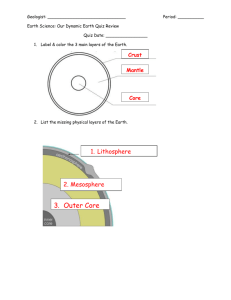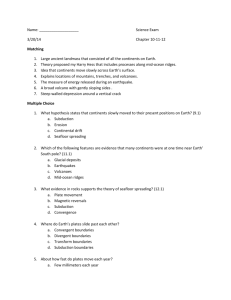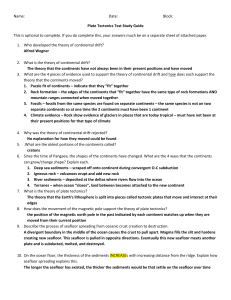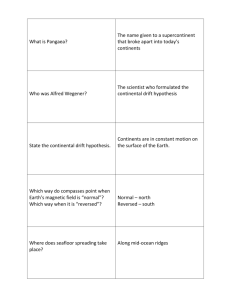Chapter 4: Plate Tectonics Lesson 4.1
advertisement
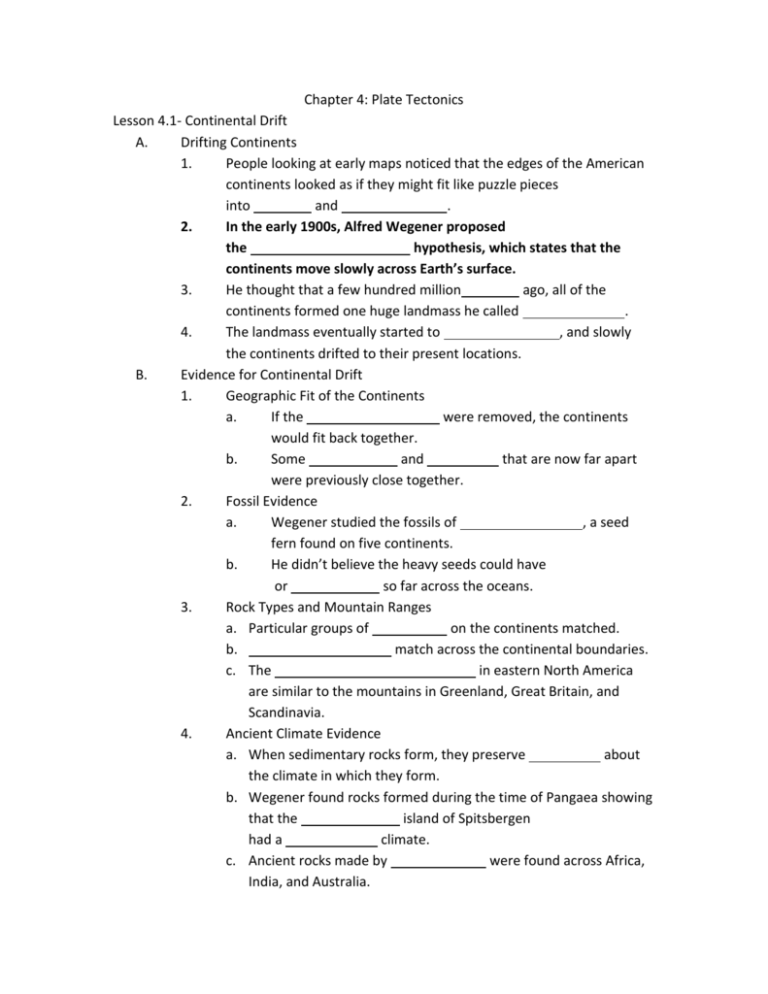
Chapter 4: Plate Tectonics Lesson 4.1- Continental Drift A. Drifting Continents 1. People looking at early maps noticed that the edges of the American continents looked as if they might fit like puzzle pieces into and . 2. In the early 1900s, Alfred Wegener proposed the hypothesis, which states that the continents move slowly across Earth’s surface. 3. He thought that a few hundred million ago, all of the continents formed one huge landmass he called . 4. The landmass eventually started to , and slowly the continents drifted to their present locations. B. Evidence for Continental Drift 1. Geographic Fit of the Continents a. If the were removed, the continents would fit back together. b. Some and that are now far apart were previously close together. 2. Fossil Evidence a. Wegener studied the fossils of , a seed fern found on five continents. b. He didn’t believe the heavy seeds could have or so far across the oceans. 3. Rock Types and Mountain Ranges a. Particular groups of on the continents matched. b. match across the continental boundaries. c. The in eastern North America are similar to the mountains in Greenland, Great Britain, and Scandinavia. 4. Ancient Climate Evidence a. When sedimentary rocks form, they preserve about the climate in which they form. b. Wegener found rocks formed during the time of Pangaea showing that the island of Spitsbergen had a climate. c. Ancient rocks made by were found across Africa, India, and Australia. d. The climates of Pangaea were the climates on Earth today. C. A Hypothesis Rejected 1. Wegener proposed that the drifted by plowing through the seafloor. 2. He thought the same that produced tides had caused the continents to slowly drift over millions of years. 3. Most other scientists did not accept Wegener’s hypothesis because they could not think of any strong enough to make continents drift. Lesson 4.2- Seafloor Spreading A. Investigating the Seafloor 1. 2. was developed for mapping the seafloor using waves. Mountain ranges in the middle of the seafloor are called . 3. The closer you move toward a mid-ocean ridge, the B. The Seafloor Moves 1. Harry Hess, an American geologist, suggested a new hypothesis describing how the seafloor gets. were formed. process by which new is the is made at the mid-ocean ridges. (Hot, less-dense material below Earth’s crust is forced upwards causing seafloor spreading). a. Convection brings hot material up from the b. toward the surface. flows out as lava through cracks along the ridge. c. Lava and forms a new seafloor. d. The seafloor moves away from the center of the . (Plates move apart from each other at the mid-ocean ridge). 2. The age of the seafloor 3. Continents drift C. Evidence for Spreading 1. with distance from the mid-ocean ridge. as the ocean grows. rock records magnetic polarity that occurs every 10,000 or more years. (Iron-rich crystals in the basalt provide scientists with evidence of magnetic polarity reversals). (The magnetic field had reversed itself several times in the past). (Scientists describe the orientation of the magnetic field today as normal). a. Scientists can measure the strength of the magnetic field with an instrument called a b. . By measuring the distance of a stripe of rock from the mid-ocean ridge and determining its age, scientists calculated the 4. of seafloor movement. The seafloor and attached continents move only per year. (The speed of plate movement can be described like the growth of a fingernail). 5. The boat named the Glomar Challenger and collected samples from the seafloor beginning in 1968. 6. Scientists found that the rocks were in the center of the mid-ocean ridge. Lesson 4.3- Theory of Plate Tectonics A. Earth’s Plates 1. Earth’s lithosphere is broken into a dozen large, brittle pieces called . 2. The theory of explains how plates and cause major geologic features and events on Earth’s surface. 3. The locations of earthquakes and volcanoes indicate the _______________ where the lithospheric plates meet. a. The edges of the plates run into, move apart, or past each other. (Earthquakes can occur when plates slide past one another). b. Plates also meet at long, deep parts of the seafloor called . B. Types of Lithosphere 1. Oceanic lithosphere is much than the continental lithosphere. a. Oceanic crust is made up of mainly of the dense igneous rocks of basalt and gabbro. b. The oceanic lithosphere is thinnest at the mid-ocean ridge and gets you move farther from the ridge. 2. lithosphere is not as thick as the oceanic crust. (Ocean floor rocks are younger than continental rocks). C. Plate Movement as 1. , which transfer heat energy from inside Earth’s mantle to the surface, are thought to drive plate movement. a. (Convection provides the matter and for plate movement). b. (Convection current describes the cycle of heating, rising, , and sinking). c. (Unlike the water in a pot, convection currents are not the same in all places in the mantle. Also, convection in Earth’s mantle is much slower than convection in water). d. Heat e. the density of rock. force pushes heated rock upward. f. A dense rock plate that sinks back into the mantle is called a . g. Hot rock material is brought near the surface and . h. Rock then cools at the surface, making new lithosphere at the ridge. i. New rock starts to move away from the . 2. Subduction Forces a. The force of gravity moves the plate downward and away from the ridge during . b. As oceanic crust cools and becomes denser, it is forced into the mantle because of the force of . D. Measuring Plate Movement 1. The Global Positioning System ( ) is a network of satellites used to determine locations on Earth and measure the direction and 2. Satellite laser ranging ( in plate movement. ) uses pulses of of plates. to measure distances



